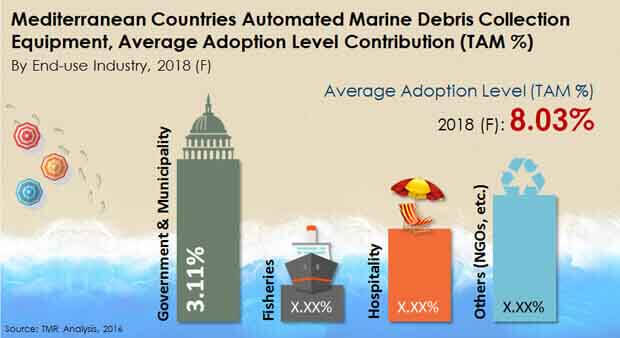
Automated Marine Debris Collection Equipment Market: Snapshot
The issue of marine debris is becoming more complex and bigger with each passing year. This, combined with the poor infrastructure for marine debris collection in Mediterranean countries and advancement in the understanding of how marine debris impact the environment and marine ecosystems are driving developments and innovations in the field of marine debris collection equipment. In this scenario, the move from the tedious and slow varieties of manual equipment to the swifter and more efficient automatic ones seems inevitable.
This market study provides an understanding and potential adoption of a conceptualized automated marine debris collection equipment across the Mediterranean region. The concept equipment is an unmanned or remotely controlled system (compact boat) designed to work in a self-contained environment, with the option of treating debris on-board or off shore. The system is typically expected to be capable of substituting the conventional hand-pick and mechanical litter collection methods. Transparency Market Research states that the market for such an automated marine debris collection equipment is anticipated to attain an average adoption level of 8% in the early year (2018) of introduction, reaching 10.2% by 2024.
This expected adoption level is measured for the estimated total accessible market in the Mediterranean region, comprising of users across segments such as government and municipality, fisheries, hospitality, others (NGOs, etc.). The anticipated level of adoption across these sectors is examined for the period between 2018 and 2024.
You will get Custom Report at Syndicated Report price, Buy Now

Importance of Cleaner Shores in Attracting Tourists to Drive Adoption in Hospitality Sector
Among the different targeted end-users of automated marine debris collection equipment, the hospitality and government and municipality sectors are expected to be the most lucrative ones, considering the direct relevance of clean environment (shores) for the hospitality business and the social stability of coastal countries. Owing to the same reasons, countries with flourishing hospitality sector and high pace of urbanization are also identified as potential markets for near term market success of automated marine debris collection equipment. The government and municipality end-use segment is anticipated to attain average adoption level contribution of 3.11% in 2018.
Availability of Funds and Proactive Initiatives to Help France Take Lead
Countries such as France, Italy and Spain in the Mediterranean are considered to be the potential early adopters of automated marine debris collection equipment as these currently have access to a larger share in funds provided by the Mediterranean Action Plan (initiated by United Nations Environment Program). Likewise, programs such as the Environment LIFE program by European Commission and dedicated government efforts are expected to further drive the market potential for automated marine debris collection equipment in these countries over the said period.
Get More Press Releases by TMR: https://www.prnewswire.com/news-releases/automotive-on-board-diagnostics-market-to-present-vast-canvas-for-oems-and-providers-to-capitalize-on-telematics-based-insurance-valuation-projected-to-touch-us-22-bn-by-2031—tmr-301290974.html
In 2018, France, with a projected adoption level of 16.85% (TAM %), is anticipated to largely dominate the Mediterranean automatic marine debris collection equipment market followed by countries including Italy, Croatia and Spain. The increasing marine litter throughout the coastline and various coastal clean-up project and initiatives undertaken across these countries on a regular basis will lay the foundation for adoption of the more effective automated marine debris collection equipment across these countries. Apart from these countries Greece and Morocco are also anticipated to have significant adoption level for such equipment.





